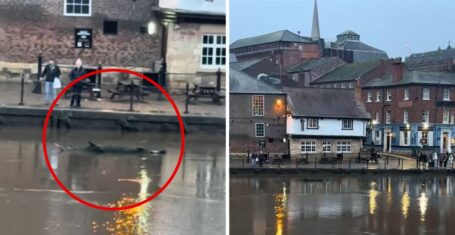
Another fish surfaces alongside the anglerfish, and the wild reason could involve volcanoes
Is it time to freak out now?
The anglerfish has surprisingly brought joy to many and fear to some. At first, people were freaking out at this terrifying-looking fish that swam all the way to the surface. Then, people couldn’t get over how cute it was that it had swam up to see the sun on its final day of living. THEN, people realised just how small it was and everyone started getting emotional. But now, people are starting to freak out because a second fish, an oarfish, has also resurfaced alongside of the anglerfish, and the wild reason could involve volcanoes.
National Geographic spoke with a senior scientist at the Monterey Bay Aquarium Research Institute, Bruce Robison, who explained a lot of the reasons behind the anglerfish’s journey to the surface. However, one of them stuck out more than most, and it involves the massive volcano in Tenerife, Mount Teide.
@bbc Researchers in Tenerife have caught what’s believed to be the first images of an adult black seadevil anglerfish near the ocean’s surface. The deep-sea predator, usually found at depths of 200 to 2,000 metres, “only survived for a few hours”, local media reported. @bbcnews #DevilFish #Fish #Sea #Nature
According to Robison, because the sighting occurred off the coast of the Canary Islands, an area known for volcanic activity, it’s possible the fish became trapped in a column of rising warm water created by undersea fissures.
In addition to the anglerfish, an oarfish which people are calling the Doomsday Fish has also recently washed up on a Canary Islands beach.
It’s not as scary as you think
“The link to reports of seismic activity goes back many, many years, but there is no scientific evidence of a connection, so I don’t think people need to worry,” said Hiroyuki Motomura, a professor of ichthyology at Kagoshima University said to the New York Post. “I believe these fish tend to rise to the surface when their physical condition is poor, rising on water currents, which is why they are so often dead when they are found.”
Most Read
And to further calm your fears – the director of the Volcanic Surveillance Area of the Volcanological Institute of the Canary Islands (that’s a hefty title), Luca D’Auria has said that it’s very unlikely an eruption will actually take place this year.
“The probability of an eruption this year would be about 2%, in the next 5 years, 40%, and in 100 years, it would exceed 90%. But this is speculation, anything can happen”, Luca explained.
He added: “There is no reason to be alarmed, nothing indicates that there will be an eruption in the short term”. Phew, our all-inclusive summer holidays are saved.
For more like this plus all the latest news, drops, quizzes and memes, like The Tab on Facebook.



















